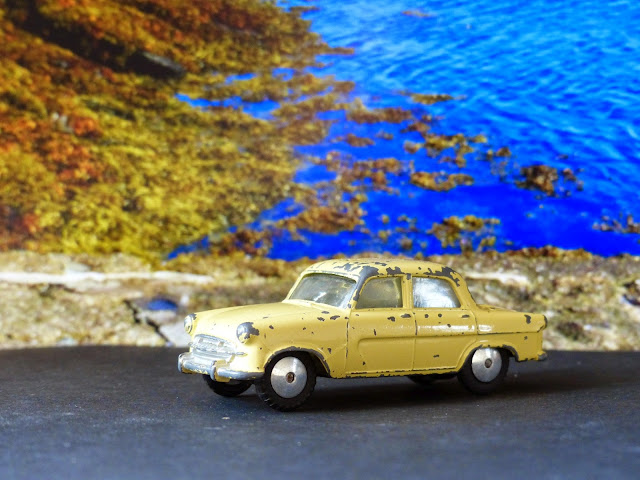The 1961 Corgi Toys Catalogue was the first to illustrate the Bentley Continental. This year was the start of all the exciting 'features' that were being incorporated in many new models. Corgi threw everything at the Bentley - as the catalogue text says: steering, jewelled head lights, ruby rear lights, opening boot, spare wheel, chrome plated radiator and bumpers, special hubs...
Special hubs? The illustration doesn't show anything different - they look like the flat wheels common at the time.
As we know the car appeared with all those lovely features except for the special hubs. It was the star of the show anyway so I, for one, didn't pay any more attention to the difference at the time. It had the shaped hubs but then so too did plenty of other models so I don't think this was the first time they'd been seen, nor would it have been the first with free spinning wheels. Or was it? Could it be that the first occasion when free spinning wheels were made available was, indeed, on the Bentley in April 1961?
We know that examples of most other models released before that could be found with shaped hubs but most were still fixed. Only a few, like the Aston Martin, Morris Mini Minor and Austin Seven would get free spinning wheels but they might well have been rather later than April 1961. We know that Corgi were playing with the idea of making the wheels spin independently at about this time as some 303S and 304S Mercedes re-issues with suspension had the old style flat wheels spinning freely so it is possible that this may have been what they meant when the catalogue was drafted.
Alternatively, there may have been a plan to create a wheel that more closely resembled the classy hubs of the real thing, perhaps with bright chrome. I have no idea. All we know for sure is that the Bentley was the only model ever produced with pale grey tyres!
There was another mystery in the 1963 catalogue, also repeated in The Great Book of Corgi: spoked wheels for the Mercedes 303s, 304S and Aston Martin 309.
The catalogue has quite clear pictures of what look like the spoked wheels used for the Buick Riviera, Chevrolet Sting Ray and others fitted to these models.
It would have been a popular move and one that made a great deal of sense as the spoked wheels were really nicely made and suited models so well. Existing wheels could have been used so there need have been no special new tooling or change in the production process other than adding a box of the spoked wheels to the selections for these lines.
What seems to have happened is that a cast wheel, with a spoke effect design (to be used across the range in years to come), was fitted to later editions of the two Mercedes models. These were discontinued soon afterwards so they're not at all common. The 218 yellow or red Aston Martins had had a crude spoke effect cast wheel only ever found on that model and it was also fixed the the axle and not at all attractive. That was discontinued in 1962, though, and mercifully we never saw those wheels again.
I have never seen any 309 Aston Martin, however, with anything other than free spinning, shaped wheels. I am surprised that they didn't fit the same cast, spoke effect wheels as they used for the Mercedes, especially as they presumably were planning these at the same time. If there ever were any Aston Martins with those cast wheels or spoked wheels then they must be seriously rare. It is not particularly difficult for someone with the right tools to switch the wheels so I am inclined to be a bit suspicious of any I did encounter anyway. But if someone would like to have a go I would love to see one!
Update 9/3/17:
I have just seen this on Ebay.
Interestingly, the seller has not shown the base which always makes me wonder, especially as this is a dealer who should know to include that. He's asking £250 which, if it's genuine, seems very reasonable. Unfortunately, I can't afford that. He has another in better condition but with the cast, spoke effect wheels, at £350. Something wrong there. It ought to be the other way round. Anyway, it looks like the Mercedes may exist.


























